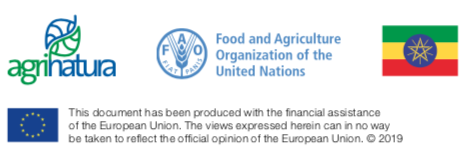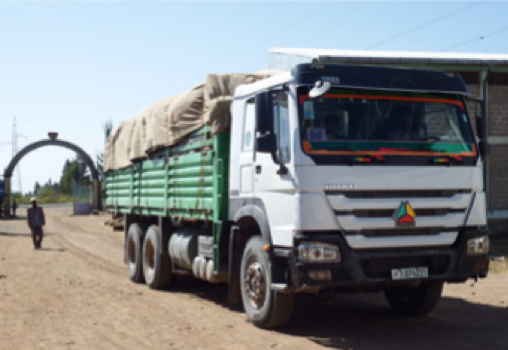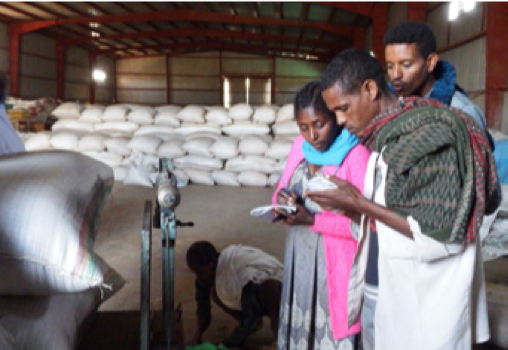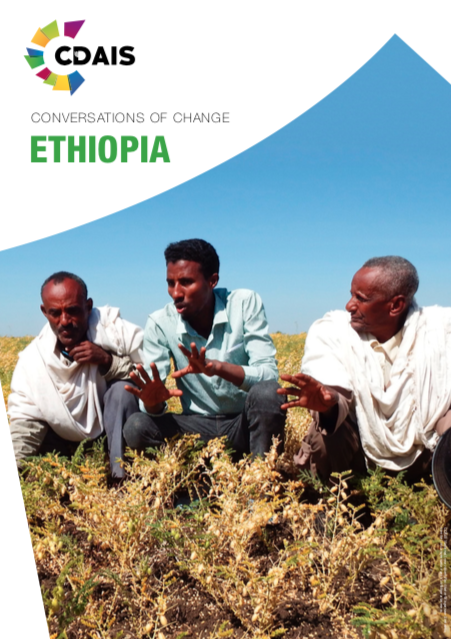
Results in Ethiopia show positive outcomes from CDAIS activities, proving the benefits of integrating functional capacity strengthening across individual, partnership, organisational and national levels. Common to all these levels are the CDAIS team, who tell their stories here alongside other partners. Examples are presented from one of the five innovation partnerships in Ethiopia, and how new ways of doing things introduced by CDAIS since late 2016 have led to positive changes through the strengthening of chickpea cluster farming around Gondar in the north of the country. Organisations involved in the support of chickpea cluster farming, such as the Ministry of Agriculture’s Extension Directorate and the NGO Self Help Africa, have also seen clear benefits from self-evaluation of their own internal processes, while CDAIS policy dialogues have led to two issues raised by farmers being transformed into concrete policy changes at the national level. And all those involved confirm that these changes are now irreversible.
Changes at farm level
“We are now becoming researchers in chickpea production”, said Awoke Tadese, one of the new chickpea cluster farmers during a field day in Dembia in January 2019. “Before, yields were low. But we identified the cause as a need for suitable crop rotation and a need to implement recommended practices for chickpea production.”
A CDAIS field day in Dembia, Gondar in January 2019, where 50 chickpea farmers shared experiences and concerns with 43 partners including extensionists, seed quarantine officers and other government officials, researchers and private actors, who also learn and offer advice. Another benefit was from the adoption of double cropping with a cereal crop grown between chickpea harvests, suggested and debated in earlier CDAIS field days. One farmer, Nega Mebiratu, was clear: “I tried double cropping, with better productivity than the previous cropping season.” (Photo: Tegegne Derbe/CDAIS)
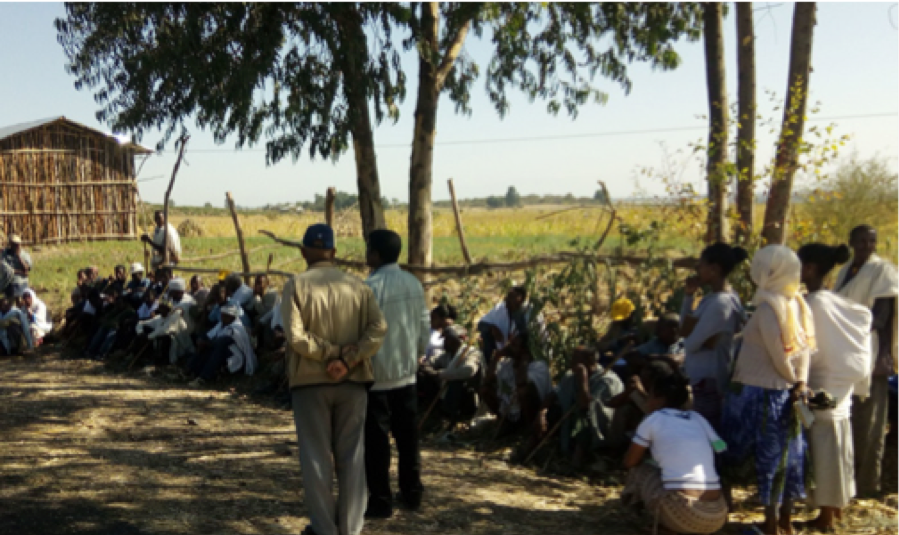
Thanks to CDAIS, the amount of certified chickpea seed arriving at Tsehay Multipurpose Farmers’ Cooperative Union has increased from 65 tonnes to 125 tonnes in two years
CDAIS introduced farmer field days, at which government officers, extensionists and researchers meet, discuss, exchange and learn with farmers directly. Awoke added that “these field days are unique because such events including the presence of all these different people do not happen anywhere else in the district and give us opportunities to tell government officials our concerns.”
Endalkachew Abie, CDAIS National Innovation Facilitator and manager of the local Tsehay Multipurpose Farmers’ Cooperative Union was proud of the benefits: “The average farm size is about 0.5 hectares, divided into small plots where different crops are grown. The government strategy is to try and ‘cluster’ farmers’ fields so larger areas of a single crop could be grown, in this
Stakeholders scale out the approach
Bringing everyone together has also had benefits for all involved, as Abebe Hailu from the Gondar Agricultural Research Centre explained: “
A similar story of clear outcomes – and that the CDAIS approach is being scaled up by the organisations involved – came from Demelew Nebiyu, Director of the Quality Control and Quarantine Gondar branch office: “Before CDAIS, I would only communicate by phone or letter, but since getting together and through the Action Plan we developed together to reach our goals, my relationship with others has changed a lot – with the seed union, government extensionists, researchers and farmers. A pivotal moment was the first field day I attended when farmers saw the benefits of clustering, and that they could keep their fields but gain extra benefits from all planting improved varieties at the same time, in the same place. From these successes, clustering is now spreading to other crops in the area. And at our quarterly
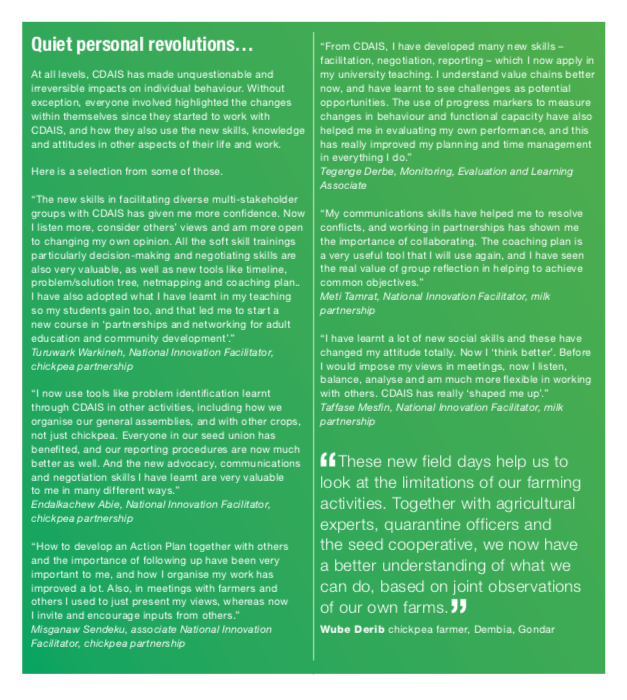
Sustainability and scaling up are also seen in other partnerships, for example with malt barley, as Chilot
Tizale, Deputy Director General of the Ethiopian Institute of Agricultural Research, explained: “We will continue to apply learnings from CDAIS in the malt barley partnership, and also look at how we can use this approach in other aspects of our organisation’s work, using our own resources. We were sceptical at first about the value of strengthening functional capacities. But over time we have seen the value of this, and that they can help to increase the impacts of using our traditional, technical approach.”

Organisational changes
Part of the CDAIS approach is to work with key innovation support service providers. This involves the CDAIS team working with an organisation to identify capacity gaps, develop a vision, and set priority objectives. This might, for example, require training to improve services and subsequent impact. Here, experiences from two of the three selected organisations in Ethiopia are shared, showing that this has led to positive outcomes that are not only sustainable, but that
“Functional capacities were not given adequate attention
Perhaps even more significant are the changes seen in the Ministry of Agriculture extension directorate, as described by its director, Yenenesh Egu: “I see this soft skill training already leading to behavioural change at all levels. A key moment was a workshop including many other ministry directorates and other external actors in October 2018.
We identified capacity gaps and developed an Action Plan, which was validated with other directorates at a follow-up workshop in December. This was all really new for us, and
it helped to build trust in our relationships, and this was fundamental in allowing us to develop a proposal to scale out the new approach. Thanks to the new confidence gained from CDAIS, I pushed for an innovative ‘integrated model village’ programme. Now the Ethiopian Government has allocated money to implement this, with potential benefits in the long term for all of our 53,000 extension staff nationwide, and the 16 million farmers who they directly support.”
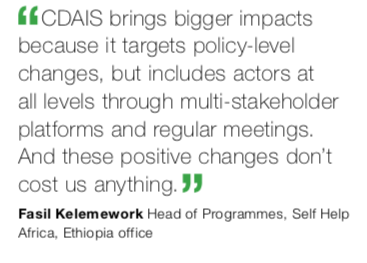
Linking farmers to organisational and national-level changes
A key concept of the CDAIS approach is not only to aim
for changes in attitudes, skills, knowledge and practices
at
A draft directive was developed and agreed at a regional policy workshop in Harwassa in May 2018, which was been submitted at the regional level in December, with formal approval expected in February 2019.
A second success was observed with the feed quality
and safety partnership, where CDAIS facilitated and supported members to develop a new directive on feed risk assessment. The directives were presented during a national dialogue in December 2018 which brought together some 45 participants. The event, officiated by the State Minister of Agriculture and the FAO Representative to Ethiopia, provided a space for actors to raise awareness on the directives and recommend actions for their approval. “The CDAIS policy dialogue also served as a space for actors to share their views with policy and decision makers and to recommend changes/improvements in policies related to the feed risk assessment, communication and management directives”, said Abdoulaye Saley Moussa from the Food and Agriculture Organization of the United Nations (FAO). These examples show how the CDAIS approach can, in just a few years, see issues raised by farmers and local-level organisations discussed at local, regional and national levels, leading to changes in government policy. And as several team members noted, “these would not have happened without CDAIS”.
Samson Eshetu, Lead National Innovation Facilitator, added, “not forgetting the national marketplace event, where members of the chickpea partnership impressed with their presentation, and interested a USAID project to support their idea for
adding value through processing. CDAIS helped the chickpea partnership to develop a technical working group and a convincing proposal, learning in the process, and they got the funding.” These are just a few examples among the many, and other changes are likely to have occurred ‘off the radar’.
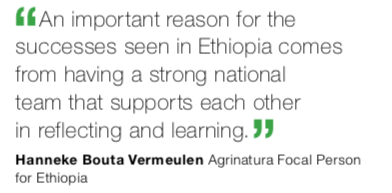

Key lessons learnt
“Before, we saw the agricultural extension-to-farmer relationship as a simple top-down approach”, said Amanuel Assefa. “But complex value chains – including producers, processors and government and private experts – require a different approach to catalyse agricultural innovation. CDAIS is the first in Ethiopia to have an integrated approach to address capacity development at individual, partnership, organisational and policy levels. Before we had theories, but thanks to CDAIS now we have concrete examples and [see] how we can overcome the challenges.” Samson concurred: “Identifying policy challenges from the grassroots level and working up was something
new that CDAIS introduced, and this gives stakeholders in the partnership level a sense of ownership and the knowledge that their voice is being heard.”
“A key part of the success of CDAIS was the training and coaching of national innovation facilitators,” explained Amanuel, “and they have proven themselves in being able to facilitate their own partnerships. Some have also been able to participate in international forums and have gained valuable experience in many other ways.” And everyone involved in the project concurs. In addition, for Elias Zerfu, Lead Monitoring, Evaluation and Learning Coordinator, “the most valuable aspect was providing a space for focused joint reflection”. Samson agreed, saying that “this is what makes CDAIS unique, along with the coaching plan as a ‘one-stop shop’, including planning, implementation and monitoring in a single document”.
But there was also reflection from the CDAIS team. “I think that innovation support service organisations offer the best opportunity for change – they could be one of the key change makers”, considered Amanuel, “Next time, it would be valuable to assess what would happen if the approach started with organisations rather than with partnerships. Also, we still have some way to go [in] bridging gaps at the highest level, especially in how strengthening functional capacities can catalyse agricultural innovations, and how we can best address bottlenecks at the national level. But I see advances and am hopeful that we can see results in the long term.” Elias agreed, adding, “the seeds of change we have helped to sow at the national level still need to grow, this will require more time”.
There have been clear outcomes of the CDAIS approach
at
for national-level changes, senior CDAIS team members considered that more time would be needed. Moreover, an extra year was requested to consolidate the progress made at all levels. But
In summary, trained and coached facilitators and appropriate tools allow for increased dialogue across all levels of agricultural innovation systems, including smallholders, and pave the way to enhance the innovation environment through adapted policies. Agrinatura Focal Person Hanneke Bouta Vermeulen concluded, “Many of these changes would not have been possible without the joint team effort. Working together with several organisations was not always easy, but we did our best to apply the principles that CDAIS promotes ourselves – of joint analysis, action, collaboration, reflection and learning. There was also room for experimentation with these new ideas on agricultural innovation
————————————————————————–
This story results from the work of the CDAIS Ethiopia country team is based on interviews with them and various other partners.
Amanuel Assefa (consultant) – Country Programme Manager; Chilot Tizale (EIAR) – National Project Coordinator; Hanneke Bouta Vermeulen (ICRA)
– Agrinatura Focal Person; Sampsom Eshetu (consultant) – Lead National Innovation Facilitator; Elias Zerfu (consultant) – Lead Monitoring, Evaluation and Learning Coordinator; Abdoulaye Saley Moussa – FAO HQ Technical Support; Simret Yasabu (consultant) – Communications; Interviews – Nick Pasiecznik (ICRA); Photographs – Nick Pasiecznik/CDAIS unless otherwise stated
See also: Innovating with chickpea cluster farming (Warkineh, T., Abie, E. and Yasabu, S.). pp96–101, in: Agrinatura and FAO, 2018. Building Competence and Confidence in Agricultural Innovation. Stories of Change. Pasiecznik, N. (ed.). Agrinatura, Paris, France and FAO, Rome, Italy. 196pp.
CDAIS is implemented in Ethiopia by Agrinatura (represented by ICRA), FAO Ethiopia and the Ethiopian Institute of Agricultural Research (EIAR), along with other partners in the various innovation partnerships.
